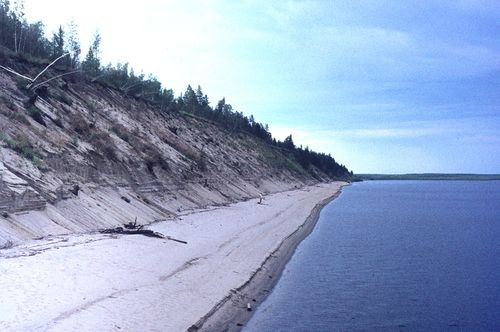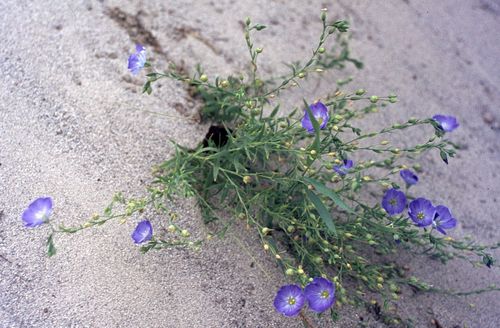Updating Middle Devensian plant macrofossils from Avon No. 2 terrace, Twyning, Gloucestershire
Paul F. Whitehead
Moor Leys, Little Comberton, Pershore, Worcestershire WR10 3EH
All pictures © Paul F. Whitehead
The sediments beneath Avon No. 2 terrace surface at Twyning, Gloucestershire yielded abundant evidence of contemporary climate and biota in an intensely cold period during the mid-last ice age or Middle Devensian (Whitehead, 1992). A finite radiometric date of 36600 (Birm-599) provides a time base for the fauna which demonstrated that the climate was intensely continental and supported a range of specialised cryoxeric species. Some of the insects are now restricted to areas of thick permafrost in northern and north-east Asia; more than 25% of the identified beetle species are now extinct in Britain. Older by an unknown amount of time were beds of orange sand overlapping the contemporary river bank onto which corpses of Steppe Bison Bison priscus Bojanus were drifted by the river and scavenged by wolves Canis lupus (L.). This rare primary context assemblage of mammals included skeletons of the Tundra Vole Microtus oeconomus (Pallas, 1776) (det. Mr A.P. Currant, BMNH, London) in situ in a traceable gallery of their burrows, a truly extraordinary finding in an open riparian site.
Following publication I was contacted by Professor R. G. West F.R.S. then head of the Botany Department at Cambridge University. He enquired on 17 August 1992 whether I had any further organic samples from Avon No. 2 terrace sediments at Twyning which could be examined for contemporary plant macrofossils. I had retained screenings from the original 900 gram organic sample 5 collected on 12 October 1974 from the bed of a palaeochannel network lightly cut into weathered Charmouth Mudstone traceable over a distance of some 109 metres. The original plant fossils from Samples 1 and 2 and 5 (Whitehead, 1992) had been determined by myself in conjunction with the specialist input of Miss Ann Conolly (University of Leicester), Mr J. E. Dandy (BMNH, London) and Dr Margaret Stant (Royal Botanic Gardens, Kew, London).
I was thus able to furnish Professor West with plant macrofossils and his colleague Dr Mary Pettit achieved excellent results from her study of them. These results were passed to me on 9 December 1993; they included 15 genera not previously recorded in channel bed samples 1, 2 or 5 in particular sedges Carex spp. Table 1 includes these new data which now updates evidence for all plant macrofossils from under Avon No. 2 terrace surface at Twyning.
Discussion
From this combined evidence it is possible to demonstrate that the water in the palaeochannels was clear, free of sediment load and set within a small-scale network evidenced by aquatic bivalve molluscs (Whitehead, 1992). A slow flow rate allowed beds of well-preserved plant material and large numbers of terrestrial molluscs to accumulate in places. The channels ran between actively eroding dissected limestone gravel beds subject to the influence of an intensely cold climate. Ice wedges penetrated the weathered surface of the Charmouth Mudstone nearby thus permitting some aspects of that climate to be quantified; their development requires a mean annual temperature of about -9oC.
01 shows a modern analogue for Twyning 36600 years ago, namely the Peschanaya Gora outcrop defining the valley side of the Lena River in Yakutia. The escarpment is formed of actively eroding sediments marking various episodes of environmental change beginning in the Middle Pleistocene and ending with Holocene aeolian sands on which taiga is developed. Mean January temperature here is in the order of -64oC, mean July temperature in the order of 38oC and mean annual temperature in the order of -10.2oC; ‘summer’ is therefore short-lived, just as it was at Twyning during the last glacial.
The palaeochannels were flanked by mosses and thickets of Dwarf Willow Salix repens L. while more stable south-facing gravel beds would have favoured Hoary Rockrose Helianthemum oelandicum DC & Lamarck. Godwin (1975) maps the recent and fossil distribution of this species in Britain. Like Perennial Flax Linum perenne L., H. oelandicum no longer has a regional presence although L. perenne did occur more widely in the Avon valley during the Devensian, sometimes as the ssp. anglicum (Miller) Ockendon (Whitehead, unpublished). Dr Pettit placed two seeds of Campanulaceae in the genus Phyteuma but with some reserve; possibly they represent Round-headed Rampion Phyteuma orbiculare L. A number of the herbaceous plants are base or halotolerant as adaptations to the fine products of soft-rock weathering. Thrift Armeria maritima (Miller) Willd. retains a rare fluvial presence in the Severn Estuary in one or two places (Cooper, 2000), whilst Sea Campion Silene uniflora Roth maintains a boreo-montane presence in Snowdonia and the Brecon Beacons. The Devensian terrestrial plant community at Twyning is essentially one of minerogenic substrates. Close modern analogues for it exist in Yakutia (01 and 02) and in the sub-alpine zone of the Carpathian mountains where Salix lanata L. is replaced by thickets of Salix retusa L
| SAMPLE NUMBERS | ||||||||
| 1 & 3 | 5 | |||||||
| Seed | Capsule | Leaf | Flower | Seed | Capsule | Leaf | Flower | |
| Ranuculaceae | ||||||||
| Ranunculus subgenus Ranunculus L. | 9 | 2 | ||||||
| Ranunculus subgenus Batrachium (DC.) A. Grey | 1* | |||||||
| Thalictrum sp. | 6 | |||||||
| Thalictrum minus L. | 1* | |||||||
| Caryophyllaceae | ||||||||
| Silene uniflora Roth | 3* | |||||||
| Armeria maritima (Miller) Willd. | 8 | 16 | ||||||
| Cistaceae | ||||||||
| Helianthemum oelandicum DC & Lamarck | 3* | 7* | ||||||
| Violaceae | ||||||||
| Viola sp. | 12 | |||||||
| Salicaceae | ||||||||
| Salix cf. herbacea L. | (twigs) | |||||||
| Salix herbacea L. | 14 | |||||||
| Brassicaceae | ||||||||
| Diplotaxis tenuifolia (L.) DC | 1* | |||||||
| Rosaceae | ||||||||
| Potentilla sp. | 1 | 2* | ||||||
| Potentilla anserina L. | 1* | |||||||
| Linaceae | ||||||||
| Linum perenne L. | 2* | 11 | ||||||
| Apiaceae | ||||||||
| Apiaceae genus indet. | 4* | |||||||
| Heracleum sphondylium L. | 1 | |||||||
| Plantaginaceae | ||||||||
| Plantago sp. | 14* | |||||||
| Pedicularis palustris L. | 1* | |||||||
| Campanulaceae | ||||||||
| Phyteuma sp. cfr | 2* | |||||||
| Asteraceae | ||||||||
| Carduus/Cirsium sp. | 1* | |||||||
| Leontodon autumnalis L. | 1* | |||||||
| Taraxacum sp. | 4 | |||||||
| Potamogetonaceae | ||||||||
| Potamogeton sp. | 3 | |||||||
| Potamogeton berchtoldii Fieber | 11 | |||||||
| Zannichellia palustris L. | 2 | 1 | ||||||
| Cyperaceae | ||||||||
| Carex spp. | 11* | |||||||
| Poaceae | ||||||||
| Poaceae genus indet. | 5* | |||||||
| Liliaceae | ||||||||
| Allium sp. | 1* | |||||||
| Nitella sp. (Charales, Characeae) | 1*oospore | |||||||
Table 1. Updated taxonomic list of plant macrofossils collected from palaeochannels at the base of Avon No. 2 terrace gravels Twyning, Gloucestershire on 12 October 1974. Asterisks * indicate the 1993 additions of Dr Mary Pettit.
Acknowledgements
I should like to thank Professor R.G. West F.R.S. and Dr Mary Pettit for their contribution to knowledge of the palaeobotany of Twyning during the Devensian full-glacial stage.
References
Cooper, S., 2000. Stephen Bishop’s new flora of Gloucestershire Part 1. The Gloucestershire Naturalist (special issue) 13:1-322
Godwin, H., 1975. History of the British flora, pp. i-x, 1-541. Cambridge University Press.
Whitehead, P.F., 1992. Terraces of the River Avon at Twyning, Gloucestershire; their stratigraphy climate and biota (with Appendices 1 & 2). Quaternary Newsletter 67:3-29.
Images
01. The Peschanaya Gora outcrop, Lena River, Yakutia 62o53’N, 129o48’E 26 July 1982; a climatic analogue for last glacial Twyning. The man on the Pleistocene-derived beach sediments conveys the scale of this vast river draining into the Arctic Ocean. © P.F. Whitehead.
02. Perennial Flax Linum perenne L., Peschanaya Gora, Lena River, Yakutia 62o53’N 129o48’E 26 July 1982 growing on Middle Pleistocene minerogenic sediments as it would have done at Twyning during that time period. © P.F. Whitehead

